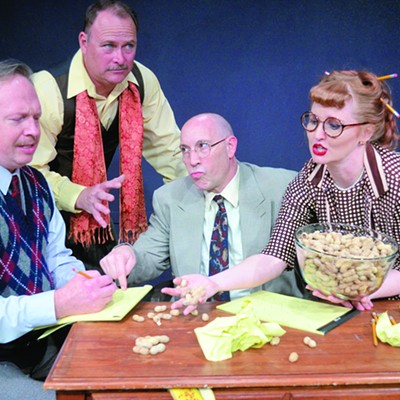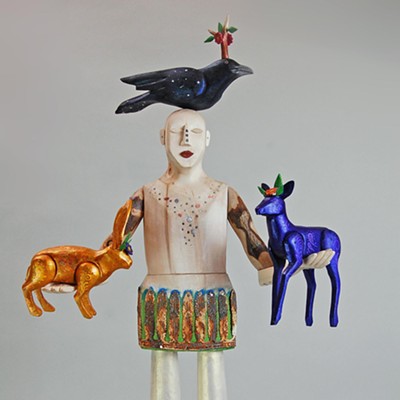New Art Faces Old Problems
Conservator Chris White Lectures on Modern-Art Preservation4 to 6 p.m., Saturday, March 15
Museum of Contemporary Art
149 N. Stone Ave.
624-5019
Art collectors have always faced the challenge of preservation. Italian frescoes dating back to the 10th century have needed substantial restoration to maintain their integrity.
But today, art lovers are facing questions like: How do I preserve my sheep encased in formaldehyde?
Chris White's lecture at the Museum of Contemporary Art will elaborate on the state of contemporary art and the materials used to create it, as well as MOCA's attempts to preserve the modern pieces.
"This is really open to anybody who collects anything," says Lissa Gibbs, the associate director of MOCA.
White, a scholar in residence working on the conservation plan for MOCA's permanent collection, plans to use case studies to illustrate some of the issues that keepers of contemporary art face regarding material usage. A prime example is the surge in plastics used to create art--hence the title of the lecture, "Off-Gassing Plastics and Chocolate Ants."
White says that plastics in the 20th century became a prevalent material among artists. And some of the artists in this movement made, as White describes, "some real unfortunate plastic choices."
Plastics, like everything else, decay. "We need to look at art objects like humans, and we need to know how to slow down that decay," White says. A piece of plastic art can decay into a state where it smells like vomit, and nobody wants that.
Admission to White's lecture costs $25 for MOCA members and $35 for nonmembers. It is the second installment of MOCA's "Collector's Series Seminars." --M.K.
Taking It Up a Notch
The Asylum Street Spankers Perform9:30 p.m., Wednesday, March 19
Plush
340 E. Sixth St.
798-1298; asylumstreetspankers.com
The Asylum Street Spankers took a break from touring to do a series of January gigs at New York City's Barrow Street Theatre. What? And Give Up Show Biz? was billed as a musical revue, similar to an early-20th-century variety show, like many of the Spankers' live shows.
Calling a Spankers' show a concert, while not a misnomer, has always been a little below the mark. The Austin-based group began honing their aggressive theatricality long before their first official off-Broadway revue. Christina Marrs and Wammo, the founding members, started busking in Austin back in 1994. They covered mostly traditional music: ragtime jazz, country-blues and old-time string-band music. But they borrowed more than just the music: They adapted the theatricality, the comedy and the variety-show atmosphere into their live show.
Marrs said that the New York musical revue--which included scripted dialogue, amateur stage acting and improv comedy--was "kind of our normal show but ... dialed up a notch. It was fun and ... challenging, and awesome to stay in one place for a few weeks and not have to get in the van."
When I spoke with her on the phone, Marrs was already back in the van, battling thick rain and Austin's horde of slow drivers to make it to band practice. Their van is stopping at Plush this Wednesday to put on one of their "normal" shows. They'll be playing two sets of songs from their new award-winning children's album, Mommy Says NO! (the irony of the Spankers taking a break from writing songs about sex, drugs and booze to record an album for children is not lost on Marrs), as well as old favorites from the last 14 years. Advance tickets are $12 at ticketweb.com. --A.M.
Watch Out! Gem Show
Jewelry Trading Days at the Arizona State Museum10 a.m. to 4 p.m., Saturday, March 15
Arizona State Museum
1013 E. University Blvd.
626-8381; statemuseum.arizona.edu
Every winter, Paddy Schwartz makes the trip from Chicago to Tucson to escape the Windy City's harsh winter. This year, she brought something different with her.
For the first time, the Arizona State Museum is hosting "Jewelry Trading Days," a concept Schwartz used with the Mitchell Museum of the American Indian in Evanston, Ill. There is one change, though: The jewelry featured here in Tucson specifically comes from the tribes of the Southwest.
The event is designed as a swap meet, since all the jewelry is previously owned and was accumulated by the museum on consignment from people who no longer want it, says Darlene Lizarraga, the marketing coordinator at the Arizona State Museum.
Belts, boas, pins and buckles that come from Southwest tribes will line the tables at the event. Entry to the event is free, and the price for an individual piece of jewelry can range from $15 to as much as a few hundred dollars.
"We did manage to keep a majority of the jewelry relatively inexpensive, with half the pieces under $50," says Schwartz. "We asked the seller for the lowest price they'll accept and made that the tag price."
The date to hand jewelry over to the Friends of the Arizona State Museum has already passed, so those who are coming to the event are limited to purchasing.
"The endless imagination and variety of the jewelry is wild," Schwartz says.
Thirty percent of the proceeds go to the museum, mainly to benefit the collections division. --M.K.
Pain on Both Sides
Faces of War ExhibitExhibit on Display 1 to 4 p.m., Sundays; through March 30
Rancho Linda Vista Gallery
American Avenue and Linda Vista Road, Oracle
(520) 626-5047; ozlemsilverstein.com
Artist Özlem Silverstein wants to create an individual memorial for each U.S. service man and woman who has died during the Iraq war. As of now, she has 99 down, but with the number of U.S. casualties near 4,000, and no end to combat in sight, Silverstein's goal may be even longer-term than the war itself.
She's uneasy with the media's detached portrayal of what she calls a body-count game: "It's just a number. ... The way it's presented to us is ridiculous and far from humanity. Numbers don't have a face. These people are not numbers."
Silverstein was born in Turkey and moved to the States in 2000, first to California and then Tucson, where she is now a fine-arts student at the University of Arizona.
Her current exhibition, Faces of War, features portraits of real U.S. soldiers. Silverstein modeled the portraits after actual photos on personal Web sites, such as memorial MySpace accounts maintained by the families of fallen soldiers. Other paintings feature the anguished faces of Iraqi mothers who lost their children in the War. "We all lose in this war," says Silverstein. "There is no victory, no mission accomplished. The only thing we have in our hands is that all of these soldiers and civilians died. There is pain in both sides."
To tease out this shared pain in her artwork, she superimposes American-quilt patterns over the portraits of U.S. troops, and Middle Eastern-carpet designs over the Iraqi mothers. The patterns celebrate the beauty of two cultures currently at odds, a sad note when juxtaposed with the dead and grieving.
The exhibit will run through March and is open to the public from 1 p.m. to 4 p.m. on Sundays, or by scheduling an appointment with the artist. --A.M.







